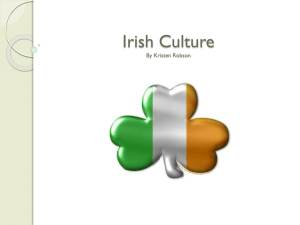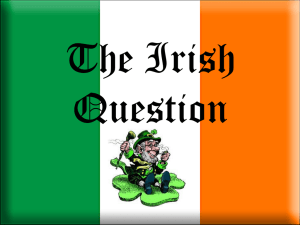Government Responses 1845-51
advertisement
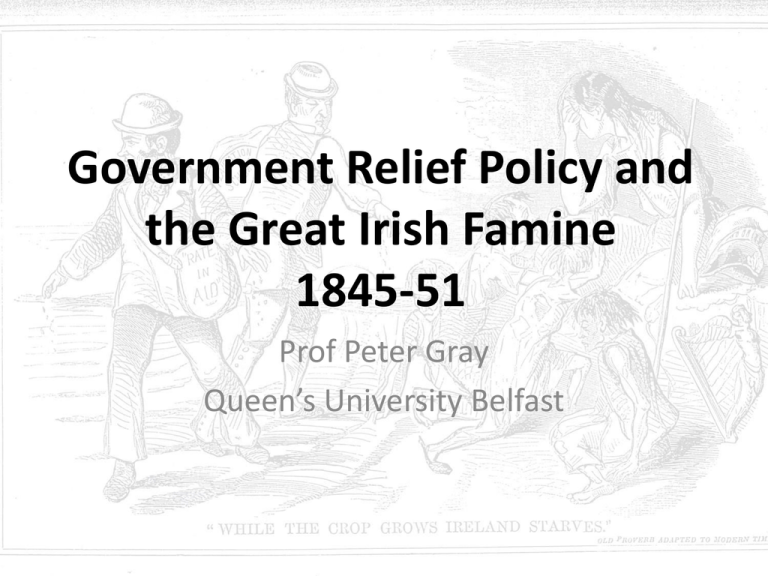
Government Relief Policy and the Great Irish Famine 1845-51 Prof Peter Gray Queen’s University Belfast Key questions • What was the governing context? Britain and Ireland in 1845 • What could government have done? • What expectations were there of government action? • What did government do? • What role did ideology play in shaping policy? • What evidence is there for ‘genocide’? • What responsibility did the state play for mass mortality? Governing Context • A colonial context? A hybrid constitutional position • From 1801 Ireland part of UK unitary state in theory • Ireland represented in Westminster Parliament – 105 MPs and 32 peers • Since 1829 Catholics admitted to Parliament; but property qualifications for vote and seats • Separate executive for Ireland at Dublin Castle under Lord Lieutenant, Chief Secretary and Under-Secretary • Separate legislation and legal structure for Ireland • Nationalist movement (Repeal) active under Daniel O’Connell from 1830 What could government have done? • Contrast government action in 1740-1 and 1845-50 • Developing financial power of state, bureaucratic organisation and reach of state agencies: Commissariat (1809) Census of Ireland (1821) / Ordnance Survey (1824) Irish Board of Works (1831) / National Education Board (1831) Irish Constabulary (1836) Irish Poor Law (1838) / Dispensaries and fever hospital network • But no separate Irish Treasury: financial power in London Expectations of state action • Little expectation of central state intervention in 18th century • Government intervention in crises from 1816-17 creates expectations • Robert Peel’s experience as CSI 1816-17, Home Secretary 1822 • Whig experience of regional crises 1831, 1835, 1839 • Small-scale intervention in west to keep down prices, provide employment • Relief directed from Dublin Castle • Debate about relationship between poor law to relief Areas of possible state intervention (1) Food availability / price - export/import policy - price control policy (2) Employment - public employment (3) Direct aid - food rationing - provision of shelter - provision of medical aid (4) Assisted emigration Soup ration tickets, 1847 Peel’s government (1841-July 1846) • • • • Conservative Party administration 1841-6 Faces limited crisis of 1845-6 Experienced in dealing with Irish famine Anxious not to concede political ground to Daniel O’Connell Sir Robert Peel (1788-1850) • Response to Irish crisis interconnected with repeal of UK Corn Laws • Political constraints: split in Conservative party early 1846 and denial of Irish crisis by ‘Protectionists’ • Charles Trevelyan (Assistant Secretary to Treasury, 1839-58 – civil servant) Peel’s policy Organisation: Relief Commission established to coordinate response 1846, chaired by Sir Randolph Routh (1) Food policy - Secret purchase of £100,000 of maize from US - Lodged in Irish depots run by Army Commissariat for release to depress grain prices - No other interference with grain trade - Hoped repeal of Corn Laws 1846 would stimulate ‘natural’ trade in maize to Ireland (2) Employment: Food riot at Dungarvan, ILN, 1846 - Public Works legislation 1846 allocates funds for employment on roads and drainage works - Terms were relatively favourable to Irish landowners; half of costs of road works granted in aid - Works put into operation spring 1846 under Irish Board of Works - Pressured by food riots and disturbances; Irish political pressure (3) Direct aid: - Government prefers to co-operate with local ‘Relief Committees’ (c.650) of private individuals and clergy - Aids local subscriptions with grants in aid - Relief committees expected to buy grain and sell at cost price; & select persons deserving relief - Govt attempts to keep relief separate from poor law (fears of outdoor relief becoming permanent) Success of Peel’s policy? • Relatively low excess mortality 1845-6 • Contains political or peasant insurgency backlash in Ireland • But calculated on basis of single year of famine; no contingency plan for 1846-7 • Provoked a political backlash in GB against ‘over-generosity’ to Irish landlords and peasants • Government falls end June 1846 on revolt against Irish Coercion Bill (Whig-Protectionist- O’Connellite alliance vs Peel) Punch on Peel’s Coercion Bill, Apr. 1846 Russell’s government (July 1846-52) • Whig-Liberal Party administration • Faces much more serious and prolonged crisis in Ireland 1846-51 • Has to deal with banking crash and recession in Great Britain, 1847-9; revolution in Europe Lord John Russell (17921848-9 1878) • A minority government 1846-7; party divided after 1847 election – Radical revolt over taxes • Weak leadership from Lord John Russell (PM); factionalism in government • Charles Trevelyan (Asst Sec to Treasury – civil servant) 3 phases in relief policy: Policy phase 1: Aug 1846-Mar 1847 Organisation: Drops Relief Commission; policy conflict between Dublin Castle and Treasury Food policy: - Abandons any new interference in food trade or pricing policy – minimal new purchases of grain - Residual use of remaining food depots in west until stocks run out - Reliance on ‘market forces’ for private imports of grain - Context of international shortages of grain 18467 (bad harvests and lack of imports) - Contributes to ‘hunger winter’ in Ireland 1846-7 - But has the role of food policy been exaggerated in causing famine? Charles Trevelyan (1807-86). Assistant Secretary to the Treasury Irish grain exports/imports (000s of tons grain equivalent) - after Bourke (1976) .exports 600 400 200 wheat 0 -200 -400 -600 -800 -1000 imports 1844 1845 1846 1847 1848 oats maize all grains (2) Employment: - Revives public works employment under ‘Labour Rate Act’ August 1846 - Insists on greater Treasury control over Board of Works works projects and reduces ‘grant in aid’ tools, 1846 - Vetoes works of ‘permanent improvement’ - Sets public works wages below level for private employment; later adopts ‘piece work’ scale of payments to labourers - Introduces ‘half-day’ wages in harsh winter of 1846-7 when work impossible - Wages did not keep pace with food price increases - Over 700,000 workers on public works by March 1847 . . (3) Direct relief: - Cuts grants in aid to relief Relief Committee ticket for relief, committees c.1846 (NMI) - Numbers of inmates in workhouses rise – many full and turning people away by late 1846 - Emphasis on private charity – promoted by government (British Association) - Limited response to medical crisis (4) No assisted emigration or interference with Canadian passenger trade despite high mortality Policy phase 2: Apr-Sept 1847 Organisation: Relief Commission re-established under Sir John Burgoyne (1) Food policy: - No dramatic change, but food Gen. Sir John Burgoyne prices falling by early summer - US maize surplus reached Europe - Imports outstrip exports from late spring 1847 (2) Employment: . - Public works rapidly phased out from March 1847 - Absence of private employment or other forms of relief in many areas - Some very limited state employment on railway and drainage schemes - Half of public works debt commuted to grant - Thousands left destitute during ‘transition’; some rioting against closure of works Proportion of population supported by public works March 1847 . (3) Direct relief: - Government follows Quakers in establishing extensive network of soup kitchens providing free rations under ‘Temporary Relief Act’ of Feb. 1847 - Lengthy bureaucratic and financial delays in setting up system – govt insists on local financial responsibility - At peak in July 1847 more than 3m daily rations doled out - Funded by loans; comes in under budget - Weak soup later replaced by ‘stirabout’ porridge - Minimum nutrition given, but has effect in lowering famine mortality in summer 1847 - Temporary fever act April 1847 allows for temporary hospitals Soup Kitchens Soyer’s model soup kitchen, Dublin (ILN, 1847) % of population on soup rations, July 1847 Drawing of soup queue, 1847 Policy phase 3: Sept 1847-1851 Organisation: Relief Commission wound up; responsibility passed to Irish Poor Law Commission, Sept 1847 (1) Food policy: - All remaining food depots wound up by 1848 - Imports continue to outstrip exports; prices remain relatively low - But food distribution limited in west and many lack ability to consume what food is available (2) Employment: - Despite debates on new public works, no serious employment policy in 1848-51 (3) Direct aid: - Soup kitchens wound up by Sept 1847 - Responsibility for relief placed on Poor Law (Poor Law Extension Act introduced Aug. 1847) - Some residual aid to ‘distressed unions’, but this was exhausted by mid-1848 . Notice of end of Soup Kitchen relief, Aug. 1847 - ‘Irish property must pay for Irish poverty’ - ‘Rate in Aid’ imposed on north and east, in spring 1849 – regional tax to pay for western distress (4) Assisted emigration: - Proposals 1848 and 1849 come to nothing - Only small-scale assistance to workhouse inmates to emigrate (Australian workhouse girls scheme) Poor Law Irish workhouse plan (1839) The Irish Poor Law • 1847-9 headed by Irish Chief Commissioner Edward Twisleton • 130 Unions each governed by part-elected Board of Guardians • Funded by rates on local property • Half of rates to be paid by landowner; also all for holdings valued under £4 pa • Quarter-acre clause of 1847 facilitates evictions • Crisis of union bankruptcy, workhouse overcrowding and disease in west • Corruption a significant problem in many unions late 1840s • Inspection regime fails to stop this • Twisleton resigns as Commissioner Mar. 1849 Londonderry Union workhouse (now museum) Dublin workhouse scene, c.1895 Failure of Russell’s policy • Mass famine mortality 1846-51 (c 1.1m excess deaths) • Failure to ensure adequate food supplies and equitable distribution to those who needed food • But capacity of state to act demonstrated under soup kitchen regime of summer 1847 • False belief that famine was ‘over’ by autumn 1847 • Withdrawal from state responsibility with reliance on locally-funded poor law relief only in 1847-51 Punch imagines the Famine over, 1847 • Failure to introduce ‘comprehensive measures’ (development works, emigration) to relieve pressure on the poor law Reasons for failure? 1. Constraints on government: - Scale of food crisis, especially in 1846-7 - International food shortage in 1846-7 - Political weakness in parliament and internal divisions within government - British recession 1847-9 and financial difficulties; growing public opposition to Irish aid - Problems of agency in Ireland (corruption, administrative inefficiency) - Lack of co-operation from local elites in Ireland 2. Ideology • No evidence for genocide (deliberate killing) • But considerable evidence of responsibility by omission and neglect. Shaped by: - Laissez-faire – reliance on market forces - Providentialism – belief that famine divinelyordained for good - Moralism – concern to force the Irish (landlords and peasants) to help themselves - Racism? – evident in some press coverage; less so in government – but concern with English opinion - Pre-occupation with permanent ‘improvement’ over immediate aid: e.g. Encumbered Estates Act 1849 Punch, 1849 ‘Moralism’ represented in visual form.

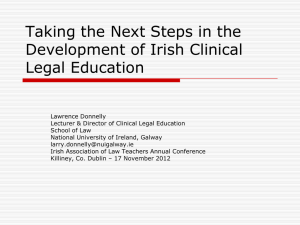

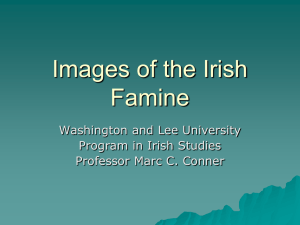
![South east presentation resources [pdf, 7.8MB]](http://s2.studylib.net/store/data/005225551_1-572ef1fc8a3b867845768d2e9683ea31-300x300.png)

